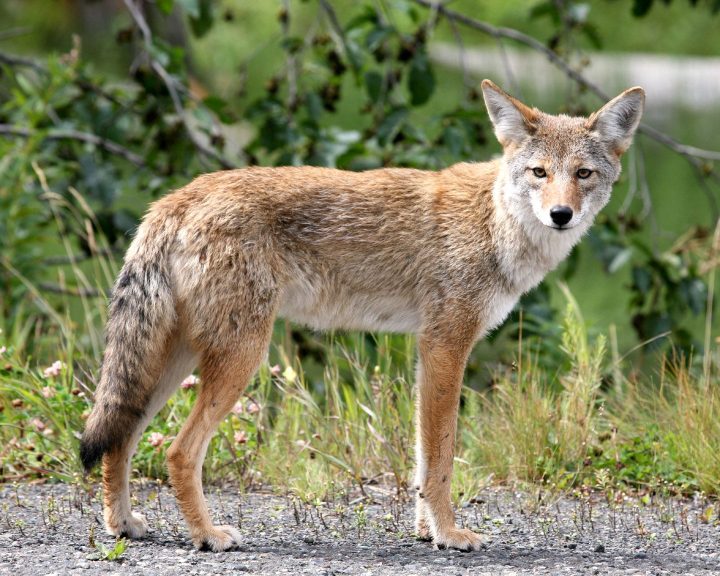
Recognize that the coyote is indigenous to Hidden Hills. The City was built in the coyote’s backyard and the coyote has adapted to this environment. We should adapt to the presence of the coyote.
Coyote (Canis Latrans)
The coyote weighs 20 to 30 pounds and stands 23 to 26 inches at the shoulder. In appearance, the coyote looks similar to a tan colored shepherd type dog with long pointed muzzle, large ears and long legs. The coyote is an extremely intelligent predator that has adapted to living in close proximity to humans. Coyotes, whose natural habitat is the Los Angeles basin, have adjusted to the shrinking habitat by living closer to humans, sometimes in residential areas, parks, and on the landscaped areas of the freeway system. Coyotes use the flood control channels, freeways, hillside erosion gutters, city streets, and sidewalks as convenient means of travel. They find an abundant source of water from swimming pools, gutters, leaking hose faucets, and sprinkler heads, bird baths and pet water dishes in residential areas.
Although the coyote is an excellent hunter, feeding primarily on rats, mice, ground squirrels, rabbits, insects, carrion and fruit, it will not hesitate to kill cats, small dogs, poultry, sheep or goats, given the opportunity. They learn that domestic animals are easier to catch than wild prey and will prowl neighborhoods in search of unattended domestic animals.
What You Can Do to Protect Your Family, Pets, Poultry and Livestock
Coyotes are capable of scaling fences up to six feet high. They will also dig under fences. They can be deterred by increasing the height of fencing and facing it outward at a 45 degree angle. Bury the bottom of the fence at least six to twelve inches underground to prevent the coyote from digging underneath. A covered enclosure set up with a pet door will permit your pet to go safely outdoors. Coyotes are wild animals and should be treated as such. No attempt should be made to pet or otherwise make contact with them.
Chicken, rabbits, and other small animals often kept outside should be kept in well-protected areas and in sturdy cages at night. Cages made of chicken wire will not keep desperate coyotes or other predators from entering. Stronger gauge wiring is a necessity in protecting these small animals. City residents are advised to give special attention to the following do’s and don’ts:
Do’s
- Keep your cat or small dog indoors at night or any other time when a coyote is known to be in the area
- Use Negative Reinforcement – let them know they are not welcome with loud noises, spray them with garden hoses, throw rocks or a rubber ball, do not stop until they leave the area
- Walk your dog on a leash whenever you take it off of your property
- Confine poultry and rabbits in covered enclosures constructed with heavy mesh wire. Coyotes can break through ordinary chicken wire
- Install motion activated lighting around your home
- Use moth balls or ammonia soaked rags around the property to deter them from entering
- Keep all outdoor trash can lids securely fastened to trash containers
- Pick backyard fruit as soon as it ripens and keep rotten fruit off the ground
Don’ts
- Don’t feed wild animals. It is illegal to feed predatory wild animals in the City of Hidden Hills
- Don’t leave pet food outside, particularly at night
- Don’t allow pets to roam from home–especially at night.
- Don’t leave water bowls for pets outdoors
- Don’t leave garbage containers open
- Don’t leave water in birdbaths or bird seed outdoors for songbirds
AGGRESSIVE COYOTE BEHAVIOR SHOULD BE IMMEDIATELY REPORTED TO CITY HALL AT (818) 888-9281 OR VIA E-MAIL TO STAFF@HIDDENHILLSCITY.ORG. PLEASE PROVIDE DATE, TIME, LOCATION AND NATURE OF INCIDENT.
